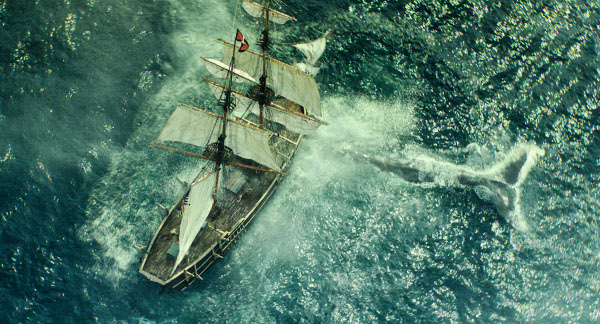
– By Cate Marquis –
‘In The Heart Of The Sea’ looks great but fitful storytelling sinks seafaring tale
Herman Melville’s novel “Moby Dick” was based in part on a real event, the sinking of the Essex by a whale, part of the whaling lore of Nantucket. That bit of real history was recounted in Nathaniel Philbrick’s non-fiction book “In the Heart of the Sea.” Director Ron Howard’s adaptation of Nathaniel Philbrick’s bestseller for the screen brings the seafaring story of man versus whale to life with first-rate 3D imagery with hunky Chris Hemsworth in the lead role. However, the sailors spend more time lost at sea than battling a whale, and with switching back-and-forth between that seafaring survival adventure and a framing story of a survivor recounting the tale to author Melville, “In the Heart of the Sea” is only a fitfully entertaining story.
What promises to be a gripping sea epic fails to live up to those expectations, although the film looks great and the effects are spectacular. To the film’s credit, it does depict some of the realities of the business of whaling in the 1820s, and of survival at sea, but there is far less action than the movie trailers suggest, and far less real history. Part of the problem is Howard’s use of a framing story to tell the tale, with author Herman Melville (Ben Whishaw) getting the tale from a reluctant survivor, Thomas Nickerson (Brendon Gleeson), who had served on the ill-fated ship as a 14-year-old (played by Tom Holland as a teen). The device is pure fiction. Melville never traveled to Nantucket before writing “Moby Dick,” but the tale of the Essex, a whaling ship attacked by a whale, was well known. The fiction does not make a bad starting point for the telling of that tale but, like Melville’s novel, this movie is only inspired by the story of the Essex, unlike Philbrick’s book.
The tale told focuses on a rivalry between two men who go to sea aboard the newly-refitted Essex, in search of whale oil, the fuel that powered things before petroleum and was just as greedily sought. One man is George Pollard Jr. (Benjamin Walker), the inexperienced captain who is a descendant of one of the island’s legendary whaling families, and the other is Owen Chase (Hemsworth), the highly-capable, experienced first-mate who was resentful at being passed over for the captaincy to ensure the suggest of this well-connected newcomer. Also aboard are Pollard’s cousin, Henry Coffin (Frank Dillane), who sometime feeds the hostility between the two, and Chase’s life-long friend, second mate Matthew Joy (Cillian Murphy), who tends to cool things down.
The action at sea is good where it occurs and the scenes with the whale are gripping. The problem is that there are too few of them, and most of the screen time is spent on their time stranded at sea after the whale sinks the Essex.
Further, instead of using the framing story to launch the Essex’s story, and only returning to it at the end, the film bounces back and forth between the two story lines, breaking the dramatic arc of both. Given that the director cast two outstanding actors, Whishaw and Gleeson, in these roles, it is understandable he wants to exploit their talents. But that would have been better done by casting them in different roles, within the main story, to begin with. However, casting the gifted Whishaw as Captain Pollard would have risked taking the focus off Hemsworth, the star picked to carry the film to box office riches. Still, it would have made for a more interesting film.
Cinematographer Anthony Dod Mantle delivers a visually lush film, whatever its other shortcomings. The seascapes depicted are lushly beautiful, and the film makes use of 3D with artistic angles of rigging, sailors and whale boats in action, and storm-swept seas, making the visual experience of this film its major delight.
The tale illustrates the bloody business of whaling, already devastating the leviathans’ numbers in 1820 when the story takes place, forcing longer, more distant voyages like the Essex’s to fill their hold with whale oil. With few whales taken and a mostly empty hold, the Essex ranges to the Pacific, where Spanish captain tells them of both a rich whaling ground and fearsome white whale. The film also uses its narrative to outlines the insular social structure of Nantucket, with class differences based on wealth but also on an almost tribal distinction between status as an off-islander or a member of a founding family, plus the commercial greed of these Quakers whose livelihood depended on the deaths of whales.
All that sounds promising but Howard tends to focus less on the history or ironies, and more on the heroics of Hemsworth. The film’s lack of epic scope and its deviation from the more interesting real story is enough to sink it.
© Cate Marquis
